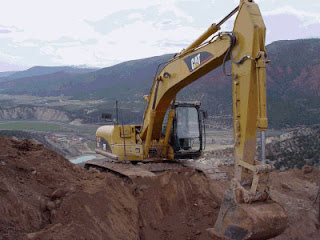Excavation is most commonly and best known for a technique within the science of archaeology. The individual types of excavation are known simply as digs to those who participate, with this being an over literal description of the process. An excavation concerns itself with a specific archaeological site or connected series of sites, and may be carried on over a number of years, since the work is normally seasonal.
Within the industry of excavation, many more techniques may be utilized, with each dig having its own particular features that may necessitate differences of approach. Resources and other practical issues don't allow archaeologists to carry out excavations whenever and wherever they choose, as many known sites have been deliberately left alone and unexcavated.
Initially, excavation involves the removal of any topsoil that is uncovered by machine. What is dug up may be examined by a metal detector for stray finds but unless the excavation site has remained untouched for a long period of time, there is a small layer of modern material on the surface that is of limited archaeological interest.
In rural areas, any type of archaeological features should be visible beneath the surface. With urban areas, they may be thick layers of human deposits and only the uppermost will be visible to the naked eye. With either case, the first task is drawing a scaled site plan that will show the
edges of the excavation.
This plan can be composed using tape measures, or as it is more common these days, an electronic total station. A grid is normally set up, to divide the site.
Excavation is also useful for digging out houses and trenches. When clearing dirt out for roads or sub divisions, excavation is what takes care of things. Even though there are a few means, the term excavation is used anytime that the earth or dirt is disturbed.
Heavy machinery is also very common with excavation, such as excavators or backhoes. Excavating crews run the equipment and dig up soil and rocks for whatever the purpose may be. Excavators are the most used machinery, as they can move a lot of dirt in a little bit of time.
Anytime you are taking part in excavation, you should always use common sense and be safe. If you plan to get down into a hole or trench, you should always use a trench box. Even though the hole may not be that deep, excavation sites can always cave in and at that point - things are very dangerous and possibly even deadly.
For digging up rare artifacts or putting in houses or roads, excavation is something that has been around for years and years. There is a lot to learn with excavation, as you'll need to know how to run machinery, shoot grade, and how to properly dig holes and trenches so they won't cave in.
To receive updates right into your inbox, please don't forget to subscribe:
Related Posts:
Trench Digging
Excavation
Trenching and Plowing Equipment
How the Earth Moving Equipment Has Changed
Within the industry of excavation, many more techniques may be utilized, with each dig having its own particular features that may necessitate differences of approach. Resources and other practical issues don't allow archaeologists to carry out excavations whenever and wherever they choose, as many known sites have been deliberately left alone and unexcavated.
Initially, excavation involves the removal of any topsoil that is uncovered by machine. What is dug up may be examined by a metal detector for stray finds but unless the excavation site has remained untouched for a long period of time, there is a small layer of modern material on the surface that is of limited archaeological interest.
In rural areas, any type of archaeological features should be visible beneath the surface. With urban areas, they may be thick layers of human deposits and only the uppermost will be visible to the naked eye. With either case, the first task is drawing a scaled site plan that will show the
edges of the excavation.
This plan can be composed using tape measures, or as it is more common these days, an electronic total station. A grid is normally set up, to divide the site.
Excavation is also useful for digging out houses and trenches. When clearing dirt out for roads or sub divisions, excavation is what takes care of things. Even though there are a few means, the term excavation is used anytime that the earth or dirt is disturbed.
Heavy machinery is also very common with excavation, such as excavators or backhoes. Excavating crews run the equipment and dig up soil and rocks for whatever the purpose may be. Excavators are the most used machinery, as they can move a lot of dirt in a little bit of time.
Anytime you are taking part in excavation, you should always use common sense and be safe. If you plan to get down into a hole or trench, you should always use a trench box. Even though the hole may not be that deep, excavation sites can always cave in and at that point - things are very dangerous and possibly even deadly.
For digging up rare artifacts or putting in houses or roads, excavation is something that has been around for years and years. There is a lot to learn with excavation, as you'll need to know how to run machinery, shoot grade, and how to properly dig holes and trenches so they won't cave in.
To receive updates right into your inbox, please don't forget to subscribe:
Related Posts:
Trench Digging
Excavation
Trenching and Plowing Equipment
How the Earth Moving Equipment Has Changed

Comments
Post a Comment
If you have comments, questions, or additional info to add in this post please share them here.